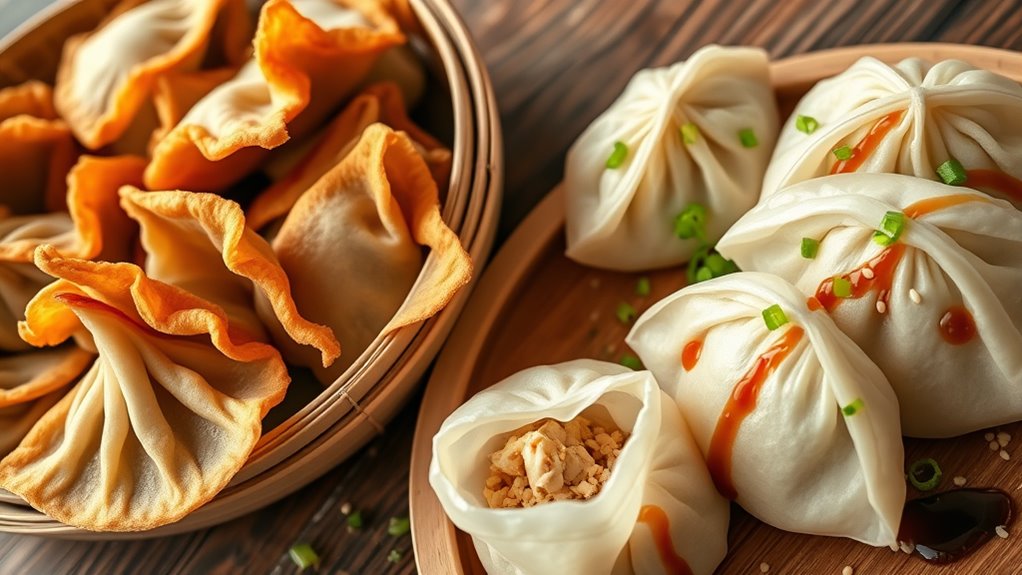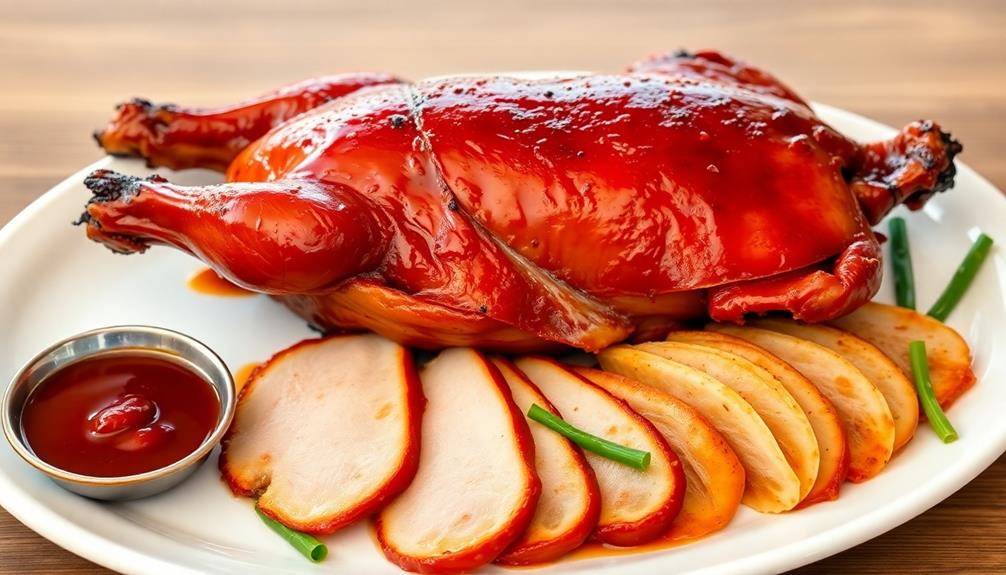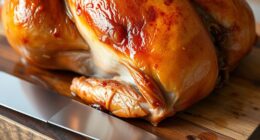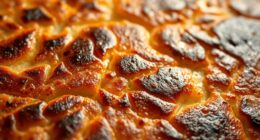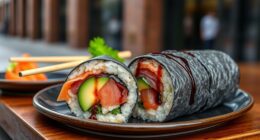Chinese dumplings offer a rich variety of flavors and styles, from crispy potstickers to fluffy bao buns. You can fill them with meats like pork, chicken, seafood, or vegetarian options such as tofu and vegetables, flavored with ginger, garlic, soy, and sesame. Cooking methods include steaming, boiling, pan-frying, or deep-frying, each creating a different taste and texture. Perfect sealing and using the right tools make a big difference—keep exploring to master these delicious techniques.
Key Takeaways
- Chinese dumplings include various styles like potstickers, bao, and boiled or steamed dumplings, each with unique textures and cooking methods.
- Fillings range from meats, seafood, or vegetables, flavored with ginger, garlic, soy sauce, and sesame oil for rich taste.
- Popular cooking techniques include steaming, boiling, pan-frying, and deep-frying, offering different textures and flavors.
- Proper wrapping and sealing ensure fillings stay intact during cooking, resulting in attractive, flavorful dumplings.
- Making dumplings at home allows customization of ingredients and techniques, connecting to a centuries-old culinary tradition.

Are you curious about the art of making Chinese dumplings? If so, you’re about to discover a world of flavors and techniques that make these bite-sized delights so irresistible. One of the most exciting parts of making dumplings is exploring dumpling filling variations. You can get creative with ingredients, mixing ground pork, chicken, beef, or even seafood with vegetables like cabbage, scallions, mushrooms, or carrots. For a vegetarian option, try combining tofu with fresh greens and herbs. The key is balancing flavors—adding ginger, garlic, soy sauce, sesame oil, or even a splash of rice vinegar can elevate your fillings. Once you’ve settled on your ingredients, the next step is mastering the cooking techniques that bring these fillings to life. You might steam, boil, pan-fry, or even deep-fry your dumplings, each method offering a distinct texture and flavor. Steaming keeps the dumplings tender and moist, perfect for delicate fillings like fish or vegetable mixes. Boiling is quick and straightforward, creating soft, juicy dumplings ideal for soups or dipping sauces. Pan-frying, especially for potstickers, gives you that crispy bottom with a tender top—this technique requires a bit of skill but results in a satisfying contrast in textures. To achieve that perfect golden crust, you start by frying the dumplings in a hot pan with a little oil, then add water to steam them until cooked through, finishing with a brief fry to crisp the bottoms. Deep-frying offers a crunchy exterior, turning your dumplings into a snack akin to Chinese fried wontons. Whichever technique you choose, make sure not to overcrowd the pan, and keep the heat steady to prevent burning or uneven cooking. When making dumplings, wrapping skills are just as important as filling choices. Use a thin, round wrapper and gently pleat the edges to seal in the delicious stuffing. Practice makes perfect—don’t worry if your first few attempts aren’t flawless. The beauty of making dumplings at home is that you can customize everything to your taste, from the fillings to the cooking method. If you want to enhance the experience, consider using a specialized equipment like a bamboo steamer or a non-stick pan designed for dumplings. As you get more comfortable, experiment with different flavor combinations and techniques to discover your favorite style. Whether you prefer soft, steaming dumplings or crispy, pan-fried ones, the process is rewarding and allows you to connect with a centuries-old culinary tradition. So gather your ingredients, sharpen your skills, and enjoy the wonderful journey of creating Chinese dumplings tailored perfectly to your palate.
Frequently Asked Questions
What Are the Origins of Chinese Dumplings?
You might not realize it, but Chinese dumplings date back over 1,800 years, originating during the Eastern Han Dynasty. They’re deeply tied to festival traditions like Chinese New Year, symbolizing wealth and prosperity. When eating dumplings, you follow certain etiquette, such as sharing them with family and respecting elders. Their long history and cultural significance reflect Chinese values, making each bite a connection to ancient customs and festive celebrations.
How Do Regional Flavors Differ in Chinese Dumplings?
You’ll find regional flavors in Chinese dumplings vary greatly, influenced by regional spice variations and ingredient differences. For instance, northern dumplings often feature hearty fillings like pork and cabbage, seasoned with ginger and scallions, while southern versions might include seafood or more delicate herbs. It’s true that these regional differences reflect local tastes, ingredients, and spice preferences, making each dumpling style unique and representative of its cultural origin.
Are There Gluten-Free Options for Dumpling Wrappers?
Yes, you can find gluten-free options for dumpling wrappers. Look for gluten-free alternatives made from ingredients like rice flour or tapioca starch. Rice paper wrappers are also a popular choice, offering a light, chewy texture without gluten. You can use these alternatives to craft delicious dumplings that suit gluten sensitivities. Just verify you check ingredient labels or make your own to avoid cross-contamination.
What Are Traditional Dipping Sauces for Dumplings?
Imagine you’re at a dim sum table, and you ask about traditional dipping sauces. You’ll find sauce variations like soy sauce, black vinegar, and chili oil, often combined for perfect flavor balance. Dipping etiquette suggests gently dunking each dumpling without excess, respecting their delicate textures. These sauces enhance the dumpling experience, allowing you to savor the blend of savory fillings and rich flavors, truly embracing the culinary tradition.
How Can I Store Leftover Dumplings Safely?
To store leftover dumplings safely, you should use proper freezing techniques. Place them in an airtight container or a sealed plastic bag, making sure to remove excess air. Label and date the package before freezing. When you’re ready to enjoy them, follow reheating tips like steaming or pan-frying to guarantee they’re heated evenly and maintain their flavor. Consume leftovers within 2-3 months for the best taste and safety.
Conclusion
Now that you know the basics of Chinese dumplings, it’s time to try, tweak, and treasure every tasty treat. Whether you’re making potstickers, bao, or beyond, embrace the experience with enthusiasm and curiosity. Remember, practice makes perfect, and each dumpling is a delicious discovery. So, savor the process, share the smiles, and celebrate your culinary creations. With a little patience and plenty of passion, your dumpling adventure will be nothing short of fantastic!
